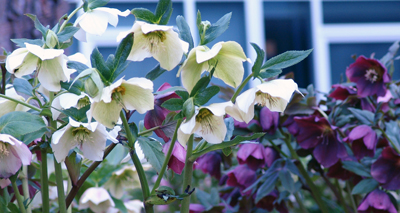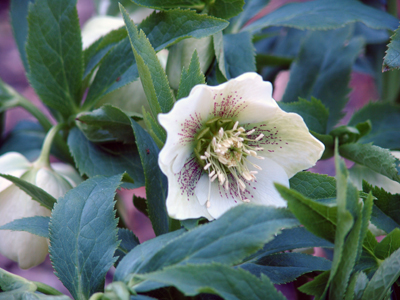Helleborus

It is official. Spring is on its way. Everyone’s mood is improving along with the weather. The doldrums of winter are fading as the remaining snow piles melt away. Color is igniting the landscape once again as spring ephemerals pop up all around the Arboretum. Pure white snowdrops, Galanthus nivalis, the winter aconite, Eranthis hyemalis, and myriads of tommies, Crocus tommasinianus are blanketing the ground. The witch hazel display continues to be as spectacular as ever, but now there are other trees and shrubs beckoning your attention. The Cornelian cherry was looking very impressive today, along with the beloved Persian ironwood, Parrotia persica. With all of this dramatic change, surely we have cause to celebrate.
Over the last few days I have been performing the normal spring maintenance of cutting back perennials, removing debris, and spreading compost. Wherever I turn a gorgeous hellebore flower is greeting me, telling me to take a moment to appreciate it in all of its splendor. So I not only have to watch my footing and garden tools, but I have to resist gazing too long at one of my favorite plants.
Helleborus niger 'Praecox' photo credit: S. Keitch
The flowers of the Helleborus species are typical of the Ranunculaceae, consisting of five sepals, which strongly resemble petals. Inside of the sepals are modified nectaries and stamens. The flowers vary widely among species in their size and color, but breeders are constantly introducing exciting new selections.
The most common species grown for their large flowers are the Christmas rose, H. niger and the Lenten rose, Helleborus x hybridus. These flowers are large, colorful and demand attention. Commonly found at local nurseries, the Helleborus X hybridus are complex hybrids with H. orientalis and other species. These are the most vigorous and dependable, and would be promising additions to your early-blooming entourage.
The foliage and stems of the different species are highly variable. Species with aerial stems, also known as caulescent, bear flowers on year-old stems. After flowering, the flower stalk dies back, forcing tender growth to be initiated each year. This fragile growth is often susceptible to winter damage. Most species are actually acaulescent, or stemless, and have extensive rhizomes underground which makes them more resilient than their stemmed relatives.

Helleborus x nigercors 'Honeyhill Joy' photo credit: R. Pineo
Hellebore leaves consist of three primary leaflets on a petiole that may be have further subdivisions. Some are roughly toothed while others have their outer leaves moderately divided, and some are divided to very fine textures.
My favorite species for texture will always be the stinking hellebore, H. foetidus. The lack of odor is somewhat disappointing, but the foliage more than compensates for the misnomer. The interspecific form Helleborus x sternii is another hybrid I would grow for its foliage alone. The simple toothed leaves are a gray-green tone that appears to have a silver finish.
Helleborus Royal Heritage Strain photo credit: S. Keitch
There are many cultivars and rare species of hellebores throughout the Scott Arboretum. I suggest a visit to the Harry Wood Garden, where the H. x hybridus ‘Kingston Cardinal’ and H. x nigercors ‘Honeyhill Joy’ are located. Other large patches of H. niger ‘Nell Lewis Strain’ and H. foetidus ‘Wester Flisk’ are blooming in the Terry Shane Teaching garden and around the Lang Performing Arts Center. I can’t imagine a better way to enjoy an outdoor walk as spring begins.





No Comments